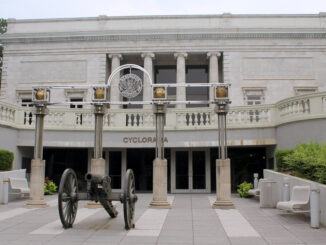KENNESAW, Ga. – The General steam locomotive pulled the morning passenger train, winding its way through the rural Georgia countryside. Shortly before 6 a.m. on a rainy morning, Engineer Jeff Cain blew the locomotive’s whistle to signal that Big Shanty was approaching.
“Big Shanty, 20 minutes for breakfast,” Conductor William A. Fuller said. The train pulled into the station, and passengers, along with the crew, exited the train and made their way into the Lacy Hotel for breakfast. The General and its cars sat idle, some passengers still on board the train.
Before too long a group of 20 men – Union spies – made their way to the front of the train and uncoupled the locomotive and three boxcars. The group – led by James J. Andrews – planned to steal the train at Kennesaw – then known as Big Shanty – and destroy the Western & Atlantic Railroad between Atlanta and Chattanooga, Tenn.
Four of them climbed into the locomotive; the rest hopped into the boxcars. Without warning, The General steamed off, marking the official start to The Great Locomotive Chase. They succeeded in commandeering the locomotive, but the plan ultimately failed.
The raid lives on in present day Kennesaw. In addition to a number of monuments dedicated to the raid located in downtown Kennesaw, The General itself is on display.
The locomotive is the centerpiece of The Southern Museum of Civil War and Locomotive History, which is located less than 100 yards from where Andrews and his men stole the steam engine 145 years ago. In addition to its extensive raid-related collection, the museum is home to many war and railroad exhibits.
The 40,000-square-foot museum also features a display about Glover Machine Works, a local engine builder. The Glover exhibit gives museum goers a look at how steam locomotives were built and how a locomotive factory would have looked. Restored Glover locomotives and wood patterns used in designing the steam engines are also on display, as is a restored belt-driven locomotive assembly line – the only one of its kind in the country.
The company built at least 200 steam locomotives during a 30-year run of production. The company started out building steam driven machinery and its first steam locomotive was shipped to the Stratton Brick Company of Macon, Georgia on May 6, 1902. The last steam locomotive was shipped on April 19, 1930, but through the 1950s, the works continued to repair the engines they built.




